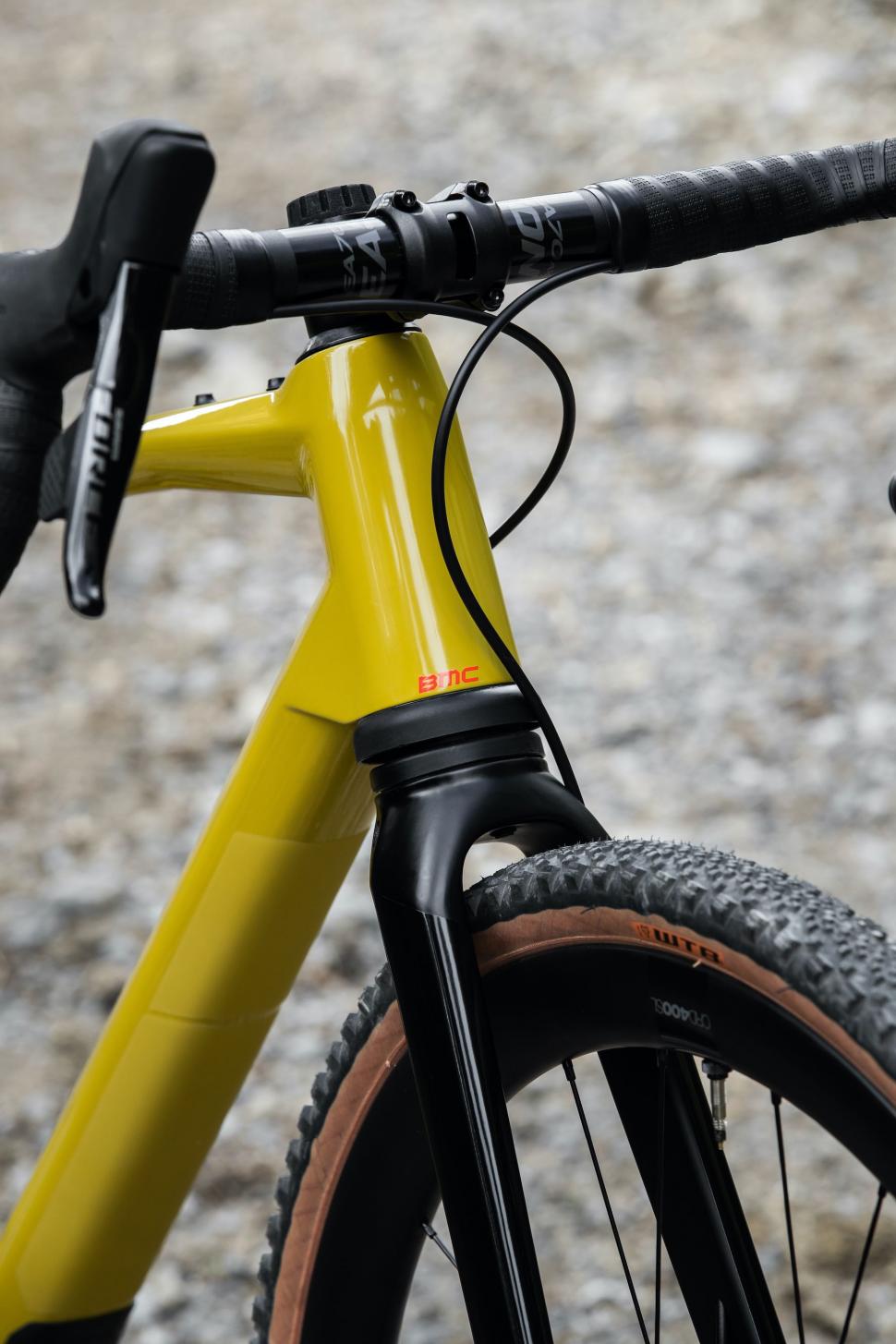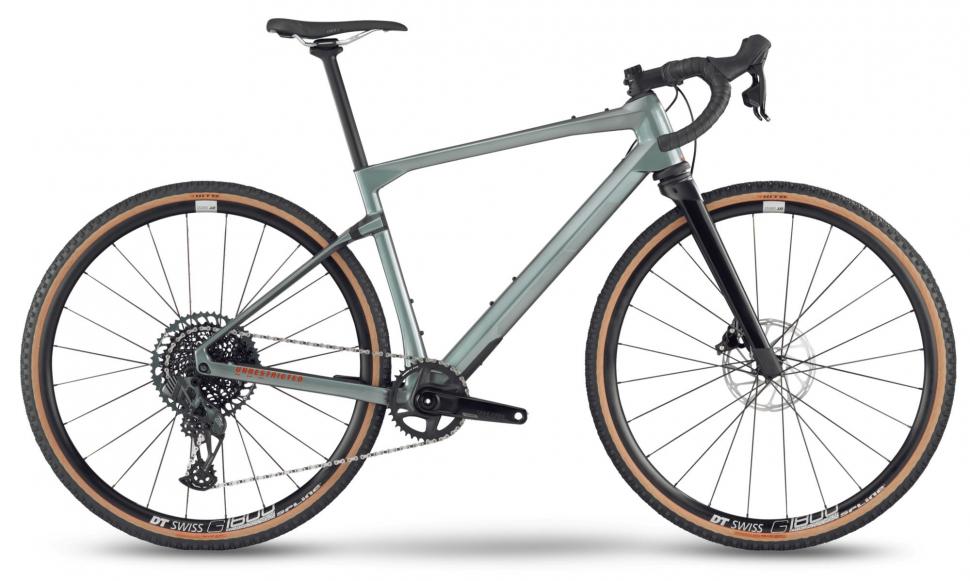- News
- Reviews
- Bikes
- Components
- Bar tape & grips
- Bottom brackets
- Brake & gear cables
- Brake & STI levers
- Brake pads & spares
- Brakes
- Cassettes & freewheels
- Chains
- Chainsets & chainrings
- Derailleurs - front
- Derailleurs - rear
- Forks
- Gear levers & shifters
- Groupsets
- Handlebars & extensions
- Headsets
- Hubs
- Inner tubes
- Pedals
- Quick releases & skewers
- Saddles
- Seatposts
- Stems
- Wheels
- Tyres
- Tubeless valves
- Accessories
- Accessories - misc
- Computer mounts
- Bags
- Bar ends
- Bike bags & cases
- Bottle cages
- Bottles
- Cameras
- Car racks
- Child seats
- Computers
- Glasses
- GPS units
- Helmets
- Lights - front
- Lights - rear
- Lights - sets
- Locks
- Mirrors
- Mudguards
- Racks
- Pumps & CO2 inflators
- Puncture kits
- Reflectives
- Smart watches
- Stands and racks
- Trailers
- Clothing
- Health, fitness and nutrition
- Tools and workshop
- Miscellaneous
- Buyers Guides
- Features
- Forum
- Recommends
- Podcast
TECH NEWS
 2022 BMC URS LT action - 3.jpeg
2022 BMC URS LT action - 3.jpegBMC updates URS gravel bike line-up with front suspension
BMC has introduced a URS LT gravel bike into its line-up with coil-sprung front suspension to go with the existing MTT (Micro Travel Technology) rear suspension system that adds 10mm of travel to the stays.
“A demand for adaptability and flexibility is key to the revised design of the URS, which includes customisable suspension and stack height, compatibility with 1x mechanical and electronic drivetrains as well as internal cable routing for a dropper post, a hub dynamo system, plus top tube mounts and more,” says BMC.
Taking the suspension first, BMC has collaborated with HiRide to create a new MTT fork with 20mm of coil-sprung travel in the steerer/head tube and a hydraulic damper. BMC says that the fork “allows riders to run optimal tyre pressures while significantly elevating the bike’s capabilities across all surfaces”, although the suspension curve has been optimised for gravel.
BMC says that the HiRide design allowed it "to retain the design and geometry of the fork's blades and crown while packing a full-featured, reliable suspension system in the head tube".
"We recognise the modern gravel tyres are incredibly capable at providing traction, rolling efficiency and damping the high-frequency vibrations, measured above 50Hz, caused by small obstacles," says BMC.
"Gravel tyres, however, find their limits on bigger obstacles like road cracks, bigger rocks and roots: the impacts these obstacles create cannot be filtered by the tyres unless very low pressures are used, compromising safety and rolling resistance.
"The MTT suspension fork is designed to overcome the limits of gravel tyres to avoid the performance compromises, damping more than 46% of the impacts typical of gravel riding that generate vibrations in the 10-50 Hz range. The bigger the impact, the lower the vibration frequency generated.
"The fine-tuned suspension performance of the MTT fork adapts to a wide range of terrains, complementing sporty and efficient riding styles while filtering out obstacles for a plush and confidence-inspiring riding feel."
The suspension unit comprises two shells. The lower steel shell contains the hydraulic chamber while the upper shell contains the coil spring and acts as the fork steerer.
The headset compressor is threaded directly in the fork steerer with the lockout knob located at the top of the headset assembly.
Specialized offers its Future Shock suspension (found in its Diverge gravel bike and Roubaix endurance road bike ranges) in a 20mm version, although the design is quite different. With Future Shock it's just the stem and handlebar that are suspended.
“In short-travel applications, coil suspension brings a host of benefits including heightened sensitivity in the first phase of travel and on light impacts (typical scenario for gravel and mellow off-road terrain) whilst staying responsive and plush under mid-to-heavy impacts,” says BMC.
“Furthermore, no weight penalty, a simple, durable design that requires less maintenance, and, unlike short-travel suspension that features air spring with limited volume, coil springs are essentially immune to overheating on long descents.”
The recently released RockShox Rudy Ultimate XPLR fork features the brand’s Solo Air spring and either 30mm or 40mm of travel.
Three different spring stiffnesses and preload spacers allow you to tune the performance according to your height, weight and style of riding. You can lock out the suspension when you don’t need it, while 4cm of stack adjustment in the steerer allows you to alter your ride position.
> Find out why stack & reach are important
The URS LT uses the same Tuned Compliance Concept (TCC) features at the rear as the existing URS bikes: a dedicated carbon layup, a D-shape seatpost, and Micro Travel Technology (MTT) stays.
BMC describes MTT as “a time-tested, mountain bike-influenced extra layer of compliance at the rear end with an XCell elastomer giving 10mm of travel… that improves traction and control on technical terrain in a featherweight, reliable and seamlessly integrated design”.
The URS LT is built to BMC’s Gravel+ geometry with a 70° head tube angle.
> How to read a bike geometry table: the numbers made easy
“This geometry system has taken cues from cross-country mountain biking: the slacker head angle combined with a long top tube and short stem gives superlative stability at high speeds and snappier steering, perfect for modern, aggressive gravel riding where precise line choice counts more at the extreme end of the genre,” says BMC.
Several other brands take a broadly similar approach, such as Merida with its Silex bikes.
BMC also boasts that the URS LT comes with cable routing for hub dynamos.
“In addition, the URS LT sticks to certain time-tested features from its predecessor: 180/160 mm flat-mount discs for powerful stopping, up to 700x45mm tyres, integrated protectors on the fork dropout, down tube and chainstays, a functional top tube mount to bolt-on top tube bags, battery lights or other accessories, BMC’s integrated Dfender for the sleekest protection against rear wheel-spray, plus compatibility with lightweight racks and mudguards enabling the rider to choose their most appropriate set-up,” says BMC.
The URS LT is available in four sizes (S-XL) and two models.
The URS LT ONE (£7,600) comes in a SRAM Force eTap AXS build with a single 38T chainset and a SRAM Eagle 10-52T cassette.
The URS LT TWO (£5,700) has a SRAM Rival eTap AXS groupset and the same gear sizes.
Mat has been in cycling media since 1996, on titles including BikeRadar, Total Bike, Total Mountain Bike, What Mountain Bike and Mountain Biking UK, and he has been editor of 220 Triathlon and Cycling Plus. Mat has been road.cc technical editor for over a decade, testing bikes, fettling the latest kit, and trying out the most up-to-the-minute clothing. He has won his category in Ironman UK 70.3 and finished on the podium in both marathons he has run. Mat is a Cambridge graduate who did a post-grad in magazine journalism, and he is a winner of the Cycling Media Award for Specialist Online Writer. Now over 50, he's riding road and gravel bikes most days for fun and fitness rather than training for competitions.
Latest Comments
- hawkinspeter 5 hours 23 min ago
Yul Brynner was a lifelong liverpool fan who didn't wear aftershave <singing> Yul never wore cologne </singing>
- dh700 6 hours 20 min ago
Unfortunately for you, you previously claimed, back on page 1, "Average distance ridden by American cyclists per year, less than 50km." Per...
- mark1a 7 hours 21 min ago
They almost certainly will; back in 2022, here in Dorset, we were due to host stage 7 of the Tour of Britain, and for the months preceding, the...
- mdavidford 7 hours 36 min ago
The way back ones don't count - he said 'in the last 20 years' (presumably the cycling equivalent of 'in the Premier League era') so it's only 2007...
- whosatthewheel 8 hours 1 min ago
Only mugs buy anything for the full retail price these days. They will soon be reduced to 299, just like the 1st gen. which went from 375 to 199 in...
- Bmblbzzz 9 hours 2 min ago
How is it only an extra 56 minutes a day? That seems to imply either the road is very busy with vehicles, in which case it might not be delivering...
- KiwiMike 9 hours 12 min ago
I've lived in Perthshire for seven years. You really should stay abreast of NZ politics - believe me, Scotland is a beacon of properiety in...
- Rendel Harris 9 hours 39 min ago
"Gloucestershire Live" headline on Facebook...you actually have to open the story to discover a car was involved and he didn't just misjudge a bend...
- leedorney 10 hours 8 min ago
Next min we'll be hearing he's related to Ursula Von Der layen
- leedorney 10 hours 9 min ago
The UCI bores strike again... once done a 1/2/3 cat race and even then then where truly unrelentless









Add new comment
6 comments
Love it, drop bar full suss should be the way forward for fast gravel riding if it can be kept simple and light (and possibly a bit cheaper...). Comparison with MTB full suss is inevitable but mostly invalid, so much of MTB suspension is designed around big bumps, steep gradients and heavy braking, gravel full suss should and could just be designed for keeping the power down over choppy ground.
I've definitely had to back off on local segments just because the jolting and vibration have gotten too bad, and I'm obviously not the Flandrien hard man that I wish I was.
I tried a suspension stem but it had a horrible effect on the handling, and my Thudbuster has rapidly turned into a sloppy rattling mess...
Just knock £2000 off the price tag BMC! Ditching the wireless gears would be a start... 🙄
Bit more travel and some flat bars and these could be quite handy.
Exactly, I'm not sure what they're trying to do here, build a MTB with drop bars? Looks like a very niche product to me.
Or leave it as it is and have something that doesn't need most people driving to a local trail centre to enjoy?
At the rate things are going we'll reinvent the MTB; it's getting a bit close to the original Californian MTB pioneers when they took some cruisers and started riding them on trails.
People have been riding bike off roads for as long as bikes have existed. Whilst that does mean few ideas are truely completely new, that doesn't mean re-visiting them with modern tech is a backwards step.
Indeed, part of the reason that "gravel" bikes have become such a big thing is (IMHO) that MTBs have got much more capable of handling tough techincal terrain, but at the expense of suitability for riding far and fast on relatively straightforward off road terrain.